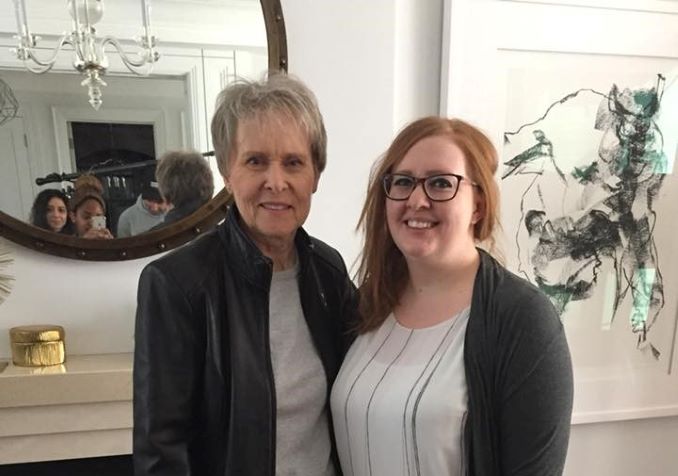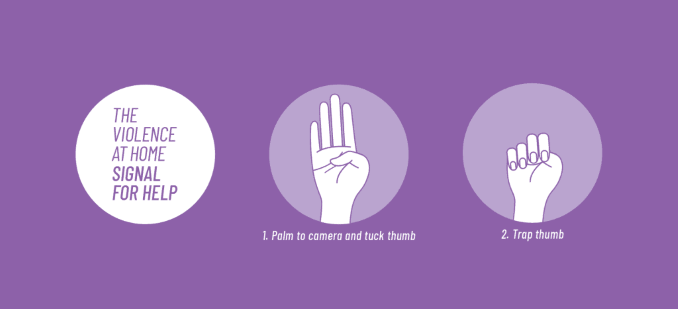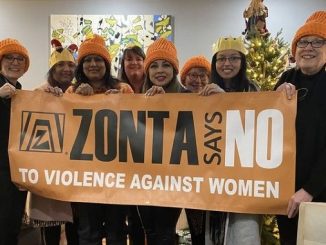The Canadian Women’s Foundation funds programs to address four urgent issues: gender-based violence, economic security, girls’ empowerment, and inclusive leadership. For this week’s Charitable Choices we had the pleasure to talk with Stacey Rodas, Manager, PR & Online Engagement at the Foundation.

Describe your charity/non-profit in a few sentences.
The Canadian Women’s Foundation is a national leader in the movement for gender equality in Canada.
Through funding, research, advocacy, and knowledge sharing, we work to achieve systemic change. We support women, girls, and gender-diverse people to move out of violence, out of poverty, and into confidence and leadership.
Since 1991, our generous donors and supporters have contributed more than $150 million to fund over 2,500 life-transforming programs throughout Canada.
What problem does it aim to solve?
Gender inequality.
In 1986, there was no national organization in Canada for people who wanted to advance gender equality. That year, two grade-school friends – Nancy Ruth and Susan Woods – started discussing what they could do about it.
They wondered: What would it take to bring about gender equality in Canada? What would it take to stop family violence and violence against women? What would it take to move women out of poverty?
What would it take for women and girls to fully embrace their power?
By the time their discussion was over, Susan had accepted a contract with The NaRuth Foundation to create a platform designed to advance women’s philanthropy.
In 1991, the Canadian Women’s Foundation was officially launched. A group of eight trail-blazing women was instrumental in getting it off the ground. The NaRuth Foundation donated $50,000 to help get the fledgling organization started. That first year, the Foundation awarded $40,000 in grants to women’s organizations.
Today, thirty years later, we fund programs to address four urgent issues: gender-based violence, economic security, girls’ empowerment, and inclusive leadership. We also work to improve systems, policies, and practices to build equity. We bring together community organizations across Canada to share knowledge and solutions, acting as a hub for grassroots leaders, issue experts, advocates, and donors working hard to keep the momentum for change.
When did you start/join it?
I joined five years ago.
What made you want to get involved?
It was the Foundation’s mission to advance gender equality for me.
I saw the Foundation as an ecosystem where there were a bunch of prongs tackling inequality of every kind: I saw they were putting out really innovative programs, policies, and public engagement efforts. I wanted to be a part of that. I saw its efforts to make transformative change in the lives of women, girls, and gender-diverse people in Canada. That was really refreshing to me – especially since, personally
speaking, I had had so many dead-end conversations with people in the past about how it’s “not so bad” to be a woman, girl, or gender-diverse person in Canada, and that “people elsewhere have it a lot worse.” It’s not about comparisons like that, it’s about every part of the world advancing equality, and Canada is no different. We have harms, injustices, and systems still in place from many years of decolonization to undo. We have discrimination that holds some of us back more than others – both interpersonally and systemically – from sexism to racism to ableism to ageism. We know that diverse women, girls, and 2SLGBTQI+ and nonbinary folks are being made to feel unsafe in public, at work, at school, and at home. We know they are undervalued and underpaid. We know they would benefit from opportunities to build confidence and leadership skills. And being such a large country, Northern, rural, and remote areas have especially unique challenges for service delivery.
I really like that the Foundation acknowledges all those elements of injustice, and has focused its efforts where the need is greatest. That, to me, feels like a really tangible way to make a change.

What was the situation like when you started? How has it changed since?
I have seen a real shift to recognize the fact that inequalities are intertwined. Intersectional feminism was not a term I had even heard of when I started, and the Foundation now applies an intersectional feminist lens to everything it does. That really means we’re getting more effective at understanding and breaking down the varied and multiple barriers that hold women back. That doesn’t mean intersectional feminism wasn’t always part of the spirit of the Foundation – one of our Foundation’s founding mothers, Rosemary Brown, had famously said “Until all of us have made it, none of us have made it.” It’s just that now I really see how the work we’re doing is being informed by that concept, in a way that has evolved so positively over the past five years.
What more needs to be done?
I usually have a pretty “stock” answer for this because things like the gender pay gap and gender-based violence are alarmingly persistent and require more and more chipping away…
But given what we’re going through now with the pandemic, I want to specifically focus on that. The pandemic laid bare the extent to which Canada’s economy depends on women’s paid and unpaid labour. Care systems weren’t working before, and we need to be ringing the alarm bells about how women and gender-diverse people are saying they are feeling right now:
– We knew before the pandemic that women were taking on the bulk of unpaid labour in the home, from cooking and cleaning to childcare and eldercare.
– We knew before the pandemic that the mental load was mostly women’s to bear. Now navigating everything from which schooling options their kids need, right down to having clean masks ready for them each day – all of that is mental load work and keeping track of household needs. As the pandemic drags on, it’s no wonder women are feeling burned out. A recent McKinsey / Lean In report found burnout is escalating much faster among women than among men. It also found one in three women have considered downshifting their career or leaving the workforce this year, compared with one in four who said this a few months into the pandemic. Earlier this year, the Foundation also, unfortunately, found something similar to the McKinsey / Lean In report: Almost half (46%) of mothers and family caregivers we surveyed said they are “reaching their breaking point.”
– We knew before the pandemic women were doing the bulk of “worry work.” Our Mother Rising survey found that in addition to shouldering more unpaid care work than fathers, women reported worrying more about their family’s mental health. This resulted in mothers carrying greater feelings of anxiety, isolation, anger, and sadness than fathers.
– The pandemic highlighted the fragility of response systems, as well as the urgent need for a structural re-think and systemic change. The systems were already broken and were already not resourced for pre-pandemic demand. Then the pandemic came and pushed demand for services way up: Since it began, many community organizations have seen a 20 to 30% increase in calls related to gender-based violence. One of our grantees, Calgary Immigrant Women’s Association, reported a 50% increase in calls for such support and said they also spent more time than usual helping clients deal with job loss, isolation, and family stress and tension.
– Gender-based violence increased dramatically in frequency and severity during the pandemic. GBV disproportionately impacts Black, Indigenous, racialized, newcomer, immigrant, refugee, and non-status women, as well as 2SLGBTQI+ and non-binary people, and those living with disabilities.
– Economic dependency and GBV are often intertwined. Many may feel they can’t leave an abusive situation for fear of falling into poverty, and being afraid to use services due to the risks posed by the pandemic may also have held some back from leaving.
– Economic losses due to COVID-19 have fallen heavily on women, and most dramatically on those living on low incomes who experience intersecting inequalities based on race, class, disability, education, migration, and immigration status. The pandemic crisis has revealed the fragility of response systems and the urgent need for structural rethinking and systemic change. Even before the pandemic, diverse women and girls were particularly impacted by economic challenges. A 2019 report by the Canadian Centre for Policy Initiatives found that in Canada there is an unequivocal pattern of racialized income inequality.
What can we do about all this?
Funded by Women and Gender Equality Canada, the Canadian Women’s Foundation was able to distribute Safer + Stronger emergency grants to community organizations tackling gender-based violence during the pandemic. Those grants helped organizations increase staffing, adapt spaces to be safe during the pandemic, and shorten waitlists. That was an excellent start, but we aren’t out of the pandemic yet, so there is much more work to be done to end gender-based violence. A National Action Plan to end gender-based violence is also underway – advocates have been calling for that for decades.
We also need affordable, accessible, quality childcare throughout Canada, as well as eldercare systems that are affordable and safe.
We definitely need an intersectional feminist pandemic recovery plan – truly, that’s where the most work needs to be done right now so that we don’t go “back to normal.” Normal wasn’t working for everyone.
– It must address how the pandemic impacts people differently and prioritize gender equity.
– As an example, the Foundation’s recent survey found only 27% of women, trans, Two-Spirit, and non- respondents report being paid equally to their peers. That number goes down to 16% for respondents with a physical disability and 23% for those with another type of disability. In this pandemic context with even worsened social inequalities, our concern is these measures will get even worse and progress toward a gender-equal Canada will stall.
– We need to invest in a new normal of living wages and equal pay, affordable child care and housing, safety and freedom from violence and discrimination.
– This is not a one-size-fits-all recovery approach. It’s really a commitment to a gender-equal future because when women thrive, everyone thrives.
How can our readers help?
One of the simplest ways to make an impact is to donate. Also, on November 25th, we’ll share how people can become “Signal Responders.” This is the next phase of our Signal for Help public awareness campaign to end gender-based violence, and the project is funded by Women and Gender Equality Canada. While we wait for that to launch, people can click here to familiarize themselves with the Signal for Help and learn what to do if they see it or if they know someone who may be experiencing gender-based violence.
Where can we follow you?
Facebook | Twitter | Instagram | LinkedIn | YouTube | Blog | Website | Contact Us | Donate
-PAY IT FORWARD: What is an awesome local charity that you love?
All of our Canadian Women’s Foundation grantees are just so inspiring. I cannot choose just one! But I’d recommend that people visit our Programs We Fund page and search by region or type of program to learn what we’re funding in their community.
If you’re going to ask me to choose a single organization, then I’m going to have to go with my former workplace, Heritage Toronto. They just recently launched a really innovative Emerging Historians program for diverse young folks.


